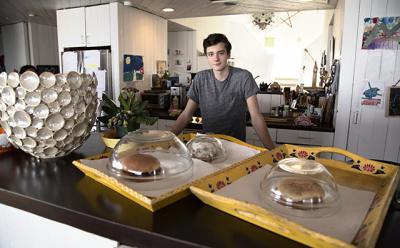Student Puts School Sandwich to the Test

There are endless stories on the Internet about experiments on McDonald's food and how it appears not to decompose over time. For a class project, an East Hampton Middle School eighth-grader put his own twist on the experiment by testing not just a breaded chicken sandwich from McDonald's but also a similar sandwich from the school's own cafeteria.
Tycho Burwell bought the McDonald's sandwich on March 23, and the next day bought the sandwich at East Hampton Middle School along with an organic, breaded chicken sandwich from Harbor Market in Sag Harbor. He placed the three sandwiches separately under clear glass bowls and waited.
The result? In a little more than two weeks, the sandwich from Harbor Market became covered in fuzzy, bluish mold. The other two sandwiches, including the one purchased at the East Hampton Middle School cafeteria, appear almost exactly as they did when Tycho first brought them home.
Tycho's experiment was part of a project inspired by the book "Omnivore's Dilemma" by Michael Pollan, which he read during Meredith Hasemann's English class. The book is about trends, politics, and critical issues affecting the food supply and consumption and in today's society.
"I had been eating the school lunches and I always felt like it was fast food, so I thought this was the perfect opportunity to test it out," he said Thursday. "I'm not eating the school lunches anymore."
After reading the book and listening to presentations by local farmers and food experts who visited her classes, Ms. Hasemann asked her students to study issues pertaining to food chains and sources and document their work in investigative reports. Tycho, a budding photographer with a following on Instagram and whose pictures have been published in The Star, is creating a photo essay documenting the three sandwiches each day. Ms. Hasemann said the book "Omnivore's Dilemma" was eye-opening for the students and called Tycho's experiment "a provocative project with a provocative approach."
He said was "honestly, not surprised" at his results. He plans on formally bringing the sandwich experiment to the school after spring break, which is the last week in April. While the East Hampton School District has already implemented many changes to its food offerings this year, Tycho said he hopes his project yields additional changes in the school cafeteria.
Whitsons, the East Hampton School District's food service vendor, responded Friday morning by saying its chicken patties are high quality, safe, and contain no artificial flavors or colors, and that its products regularly undergo quality testing in a government-certified facility.
"We go above and beyond the national guidelines" for school nutrition, Katherine Barfuss, the nutrition services manager at Whitsons, said. "There's nothing in the chicken patty that would go against any of our standards there."
According to nutrition information provided by Whitsons, the chicken patty in question is made of chopped chicken with a whole-grain-rich breading. It has soy added. The 3.1-ounce patty contains 230 calories, 15 total grams of fat, 280 milligrams of sodium, and 12 grams of protein.
Ms. Barfuss said the appearance of mold is actually not a factor in determining whether a product is of poor quality. It is "usually the last thing that would grow on the product, rather than the first thing," she said.
Those with questions or concerns about the school food may contact Whitsons at 424-2700.
East Hampton Middle School has made headlines in the past for its efforts to provide nutritious, high-quality lunches for its students. In 2005, students at the school staged a sit-in protest as a means of asking the administration for healthier food options, a cause that was then taken up by the Wellness Foundation of East Hampton. The school and the foundation were later featured in the film "Fat, Sick, and Nearly Dead 2" by Joe Cross, a documentarian and health advocate.
"I'd say the result I would want to see, and I'm not saying this is possible at all because they have to keep their costs low, but I would like to see a more organic version of their food," Tycho said. "I can understand that it is a problem because it costs more, and that's why a lot of people eat at McDonald's, but organic food is better overall."
Christine Sciulli, Tycho's mother, said her son's experiment "begs the question, 'Why do the schools give the children this food?' "
"You can ask the questions, but you need to provide solutions, and that's where the problem comes in," she said. "I think it's really hard to be critical because of the constraints. People can always make their own lunches if they are appalled by it, but if the school didn't provide lunches, a lot of kids just wouldn't eat."
